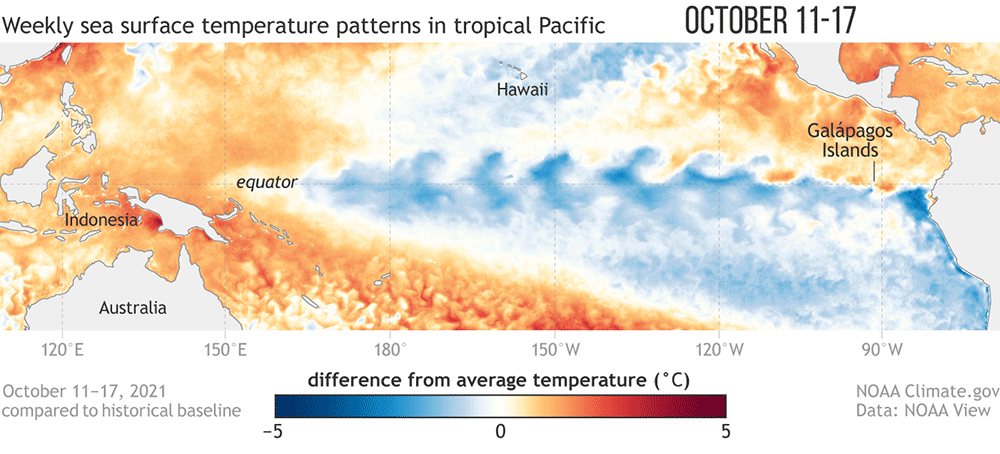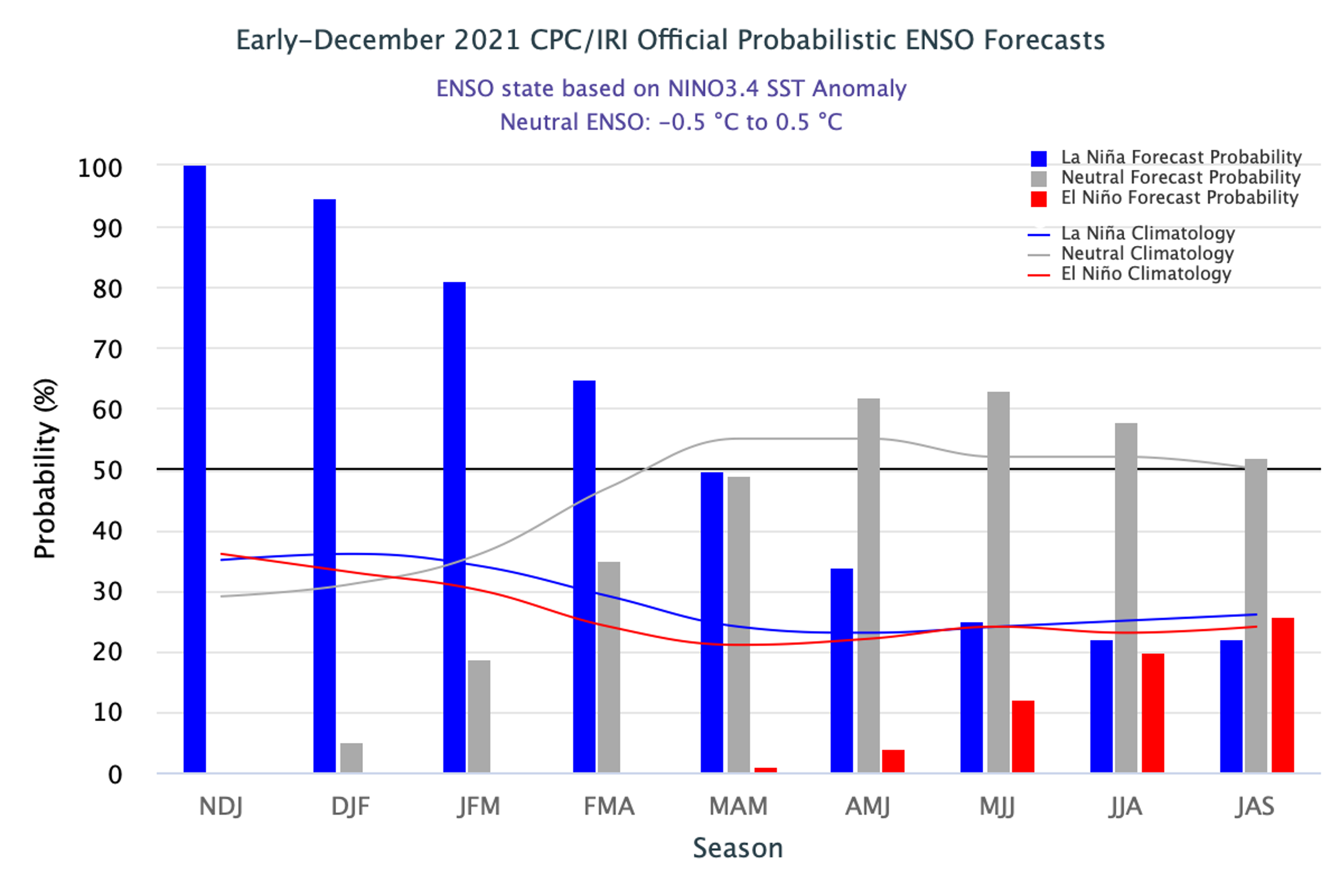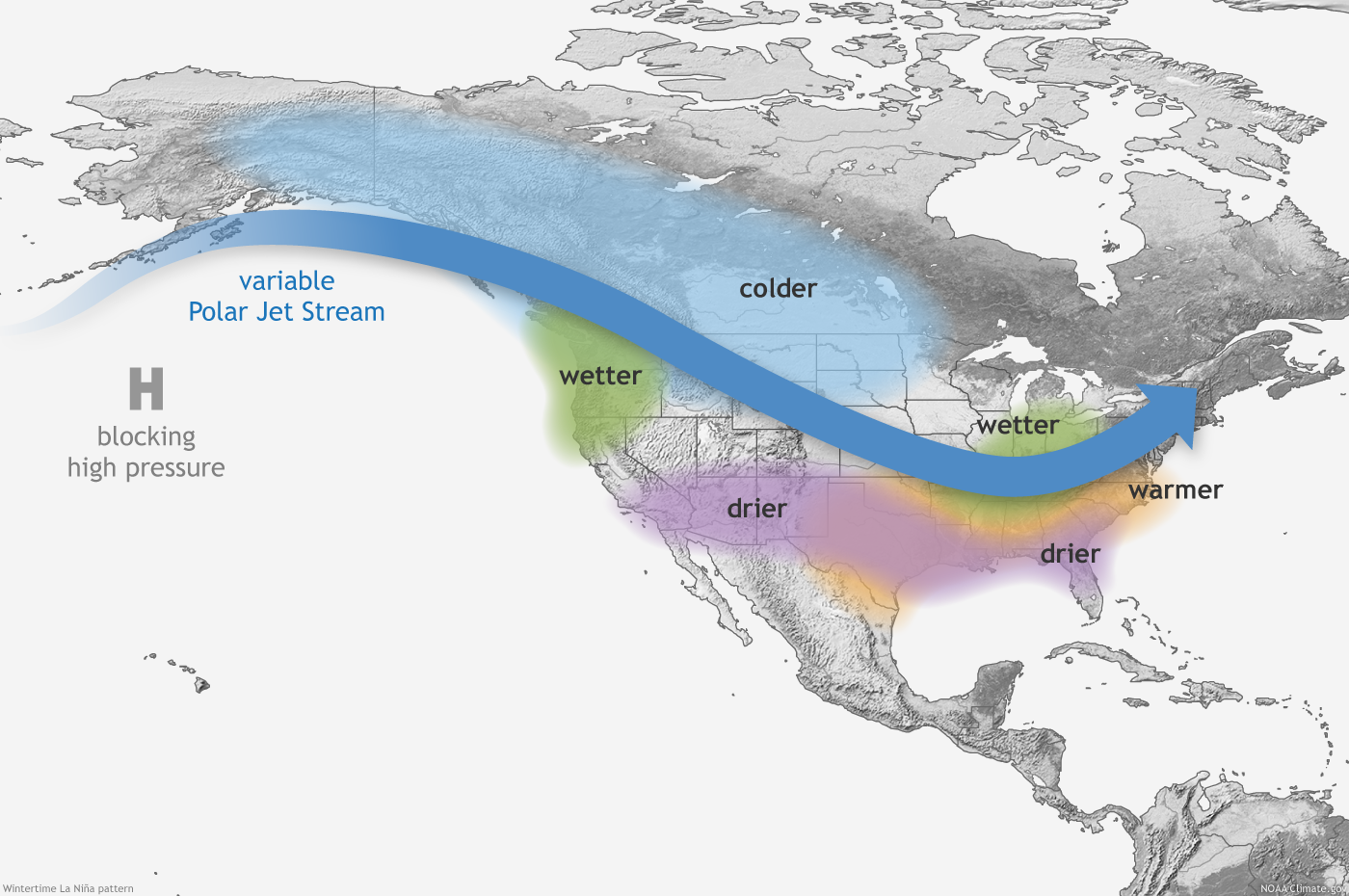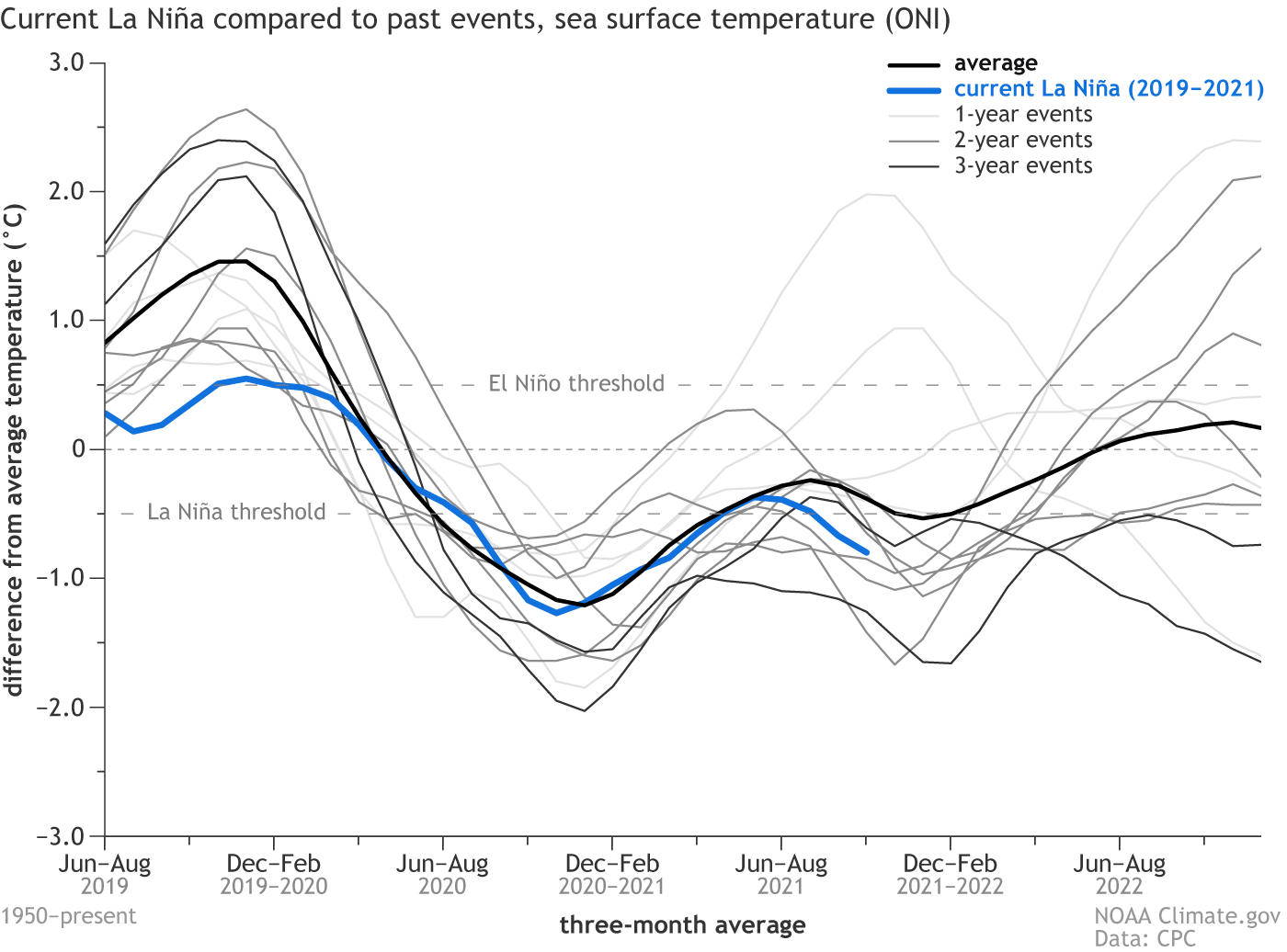December La Niña Update: Visual Aids
Special Stories
21 Dec 2021 1:00 AM
[November 2021 sea surface temperature departure. Image from Data Snapshots on NOAA Climate.]
[From NOAA Climate written by Emily Becker] La Niña continues as the Northern Hemisphere heads into winter, and forecasters are confident that it will hang around through the rest of the winter. This La Niña, the second in two years, will likely transition to ENSO-neutral sometime in the spring. There’s about a 60% chance the late spring and summer will feature neutral conditions.
 [Sea surface temperature difference from the long-term average from mid-October 2021 to early December. Graphic by Climate.gov, based on data from NOAA’s Environmental Visualization Lab. Description of historical baseline period here.]
La Niña’s hallmark cooler-than-average ocean surface is readily apparent across much of the tropical Pacific. Over the past few weeks, cool anomalies have increased in the eastern Pacific, and in general we see a well-established La Niña pattern. Also characteristic of La Niña is the warmer-than-average surface temperatures in the far western Pacific.
The wavy features in the animation above are called tropical instability waves. The equatorial eastern Pacific is usually cooler than the water just to the north and south, and cooler than the water in the far western Pacific. (Scientists refer to this region as the “cold tongue,” unfortunately.) This cooler surface right along the equator is due to cold water upwelling from the deep ocean. Any time there is a temperature difference, or gradient, between cold and warm, nature wants to smooth it out, and tropical instability waves help to mix the cooler equatorial surface with the warmer off-equatorial water to the north and south.
During La Niña, the cold tongue is even colder (shudder), so we often see prominent tropical instability wave action. These waves move relatively quickly, so they usually don’t show up in monthly or seasonal sea surface temperature maps.
[Sea surface temperature difference from the long-term average from mid-October 2021 to early December. Graphic by Climate.gov, based on data from NOAA’s Environmental Visualization Lab. Description of historical baseline period here.]
La Niña’s hallmark cooler-than-average ocean surface is readily apparent across much of the tropical Pacific. Over the past few weeks, cool anomalies have increased in the eastern Pacific, and in general we see a well-established La Niña pattern. Also characteristic of La Niña is the warmer-than-average surface temperatures in the far western Pacific.
The wavy features in the animation above are called tropical instability waves. The equatorial eastern Pacific is usually cooler than the water just to the north and south, and cooler than the water in the far western Pacific. (Scientists refer to this region as the “cold tongue,” unfortunately.) This cooler surface right along the equator is due to cold water upwelling from the deep ocean. Any time there is a temperature difference, or gradient, between cold and warm, nature wants to smooth it out, and tropical instability waves help to mix the cooler equatorial surface with the warmer off-equatorial water to the north and south.
During La Niña, the cold tongue is even colder (shudder), so we often see prominent tropical instability wave action. These waves move relatively quickly, so they usually don’t show up in monthly or seasonal sea surface temperature maps.
 [The official CPC/IRI ENSO probability forecast. The bars show the seasonal chances for each possible ENSO state—El Niño (red), La Niña (blue), and neutral (gray) from late fall 2021 through summer 2022. The forecast is based on a consensus of CPC and IRI forecasters, and it is updated during the first half of the month, in association with the official CPC/IRI ENSO Diagnostic Discussion. It is based on observational and predictive information from early in the month and from the previous month. Image from IRI.]
Forecasters think the most likely scenario is for La Niña to transition to neutral by the late spring. Neutral is the most common state for ENSO in the spring, and most computer models predict the Niño-3.4 Index to be in the neutral range (between -0.5 and 0.5 °C) by the April–June season.
We spend so much time and energy on El Niño and La Niña because they have a substantial impact on winter weather and climate around the globe. (Also, because they’re interesting!) La Niña shifts the Pacific jet stream, the fast-moving river of air that steers storms across North America. Specifically, during La Niña, the jet stream retracts to the west, and an area of high pressure tends to form in the north Pacific. These changes lead to a reduced number of storms coming onshore along the southwestern U.S. coast and hence drier conditions. On the other hand, the storm track tends to get deflected to the north, leading to wetter conditions in the Pacific Northwest. For lots more detail about how this works, check out this post on La Niña and the jet stream.
[The official CPC/IRI ENSO probability forecast. The bars show the seasonal chances for each possible ENSO state—El Niño (red), La Niña (blue), and neutral (gray) from late fall 2021 through summer 2022. The forecast is based on a consensus of CPC and IRI forecasters, and it is updated during the first half of the month, in association with the official CPC/IRI ENSO Diagnostic Discussion. It is based on observational and predictive information from early in the month and from the previous month. Image from IRI.]
Forecasters think the most likely scenario is for La Niña to transition to neutral by the late spring. Neutral is the most common state for ENSO in the spring, and most computer models predict the Niño-3.4 Index to be in the neutral range (between -0.5 and 0.5 °C) by the April–June season.
We spend so much time and energy on El Niño and La Niña because they have a substantial impact on winter weather and climate around the globe. (Also, because they’re interesting!) La Niña shifts the Pacific jet stream, the fast-moving river of air that steers storms across North America. Specifically, during La Niña, the jet stream retracts to the west, and an area of high pressure tends to form in the north Pacific. These changes lead to a reduced number of storms coming onshore along the southwestern U.S. coast and hence drier conditions. On the other hand, the storm track tends to get deflected to the north, leading to wetter conditions in the Pacific Northwest. For lots more detail about how this works, check out this post on La Niña and the jet stream.
 [Average location of the jet stream and typical temperature and precipitation impacts during La Niña winter over North America. Map by Fiona Martin for NOAA Climate.]
The outlook for this winter’s climate in the U.S. was detailed in this recent post. Mike Halpert discusses the higher chance of dry conditions throughout the southern tier, a hallmark of La Niña. Also, for something you could probably see with your naked eyes, check out the discussion of the December 2021 outlook.
[Average location of the jet stream and typical temperature and precipitation impacts during La Niña winter over North America. Map by Fiona Martin for NOAA Climate.]
The outlook for this winter’s climate in the U.S. was detailed in this recent post. Mike Halpert discusses the higher chance of dry conditions throughout the southern tier, a hallmark of La Niña. Also, for something you could probably see with your naked eyes, check out the discussion of the December 2021 outlook.
 [This graph shows 3-month-average sea surface temperature anomalies in the Niño 3.4 region of the tropical Pacific (the Oceanic Niño Index) for 2019–21 (blue line) and all other years (gray lines) based on the twelve first-year La Niña winters since 1950. The average of all twelve is shown by the black line. Four La Niñas lasted only one year (light gray lines), six lasted two years (medium gray), and two recurred for three years in a row (dark gray). Climate.gov graph inspired by original from Mike McPhaden.]
One interesting thing to note about La Niña 2020–22 is that, unlike the other 11, it did not follow a full-blown El Niño. The tropical Pacific was warmer than average in 2019–2020 but did not meet El Niño thresholds.
Mike McPhaden had this to say about recurring La Niña in general and this year in specific: "The likelihood of a double-dip La Niña increases for stronger preceding El Niños because the subsurface heat content in the equatorial band is usually more depleted following strong El Niños, providing extra inertia to sustain subsequent surface cooling over multi-year periods. What then accounts for the current 2-year cold event, which was preceded by only very weak El Niño-like warming, is an interesting research topic."
And so, as much as we’d like to get an idea of the next winter, it’s still too soon. The minute forecasters have a clearer picture, though, we’ll pass it on to you!
[This graph shows 3-month-average sea surface temperature anomalies in the Niño 3.4 region of the tropical Pacific (the Oceanic Niño Index) for 2019–21 (blue line) and all other years (gray lines) based on the twelve first-year La Niña winters since 1950. The average of all twelve is shown by the black line. Four La Niñas lasted only one year (light gray lines), six lasted two years (medium gray), and two recurred for three years in a row (dark gray). Climate.gov graph inspired by original from Mike McPhaden.]
One interesting thing to note about La Niña 2020–22 is that, unlike the other 11, it did not follow a full-blown El Niño. The tropical Pacific was warmer than average in 2019–2020 but did not meet El Niño thresholds.
Mike McPhaden had this to say about recurring La Niña in general and this year in specific: "The likelihood of a double-dip La Niña increases for stronger preceding El Niños because the subsurface heat content in the equatorial band is usually more depleted following strong El Niños, providing extra inertia to sustain subsequent surface cooling over multi-year periods. What then accounts for the current 2-year cold event, which was preceded by only very weak El Niño-like warming, is an interesting research topic."
And so, as much as we’d like to get an idea of the next winter, it’s still too soon. The minute forecasters have a clearer picture, though, we’ll pass it on to you!
Magnifying glass
Time for a closer look at the tropical Pacific, the home of the El Niño-Southern Oscillation climate pattern! [Sea surface temperature difference from the long-term average from mid-October 2021 to early December. Graphic by Climate.gov, based on data from NOAA’s Environmental Visualization Lab. Description of historical baseline period here.]
La Niña’s hallmark cooler-than-average ocean surface is readily apparent across much of the tropical Pacific. Over the past few weeks, cool anomalies have increased in the eastern Pacific, and in general we see a well-established La Niña pattern. Also characteristic of La Niña is the warmer-than-average surface temperatures in the far western Pacific.
The wavy features in the animation above are called tropical instability waves. The equatorial eastern Pacific is usually cooler than the water just to the north and south, and cooler than the water in the far western Pacific. (Scientists refer to this region as the “cold tongue,” unfortunately.) This cooler surface right along the equator is due to cold water upwelling from the deep ocean. Any time there is a temperature difference, or gradient, between cold and warm, nature wants to smooth it out, and tropical instability waves help to mix the cooler equatorial surface with the warmer off-equatorial water to the north and south.
During La Niña, the cold tongue is even colder (shudder), so we often see prominent tropical instability wave action. These waves move relatively quickly, so they usually don’t show up in monthly or seasonal sea surface temperature maps.
[Sea surface temperature difference from the long-term average from mid-October 2021 to early December. Graphic by Climate.gov, based on data from NOAA’s Environmental Visualization Lab. Description of historical baseline period here.]
La Niña’s hallmark cooler-than-average ocean surface is readily apparent across much of the tropical Pacific. Over the past few weeks, cool anomalies have increased in the eastern Pacific, and in general we see a well-established La Niña pattern. Also characteristic of La Niña is the warmer-than-average surface temperatures in the far western Pacific.
The wavy features in the animation above are called tropical instability waves. The equatorial eastern Pacific is usually cooler than the water just to the north and south, and cooler than the water in the far western Pacific. (Scientists refer to this region as the “cold tongue,” unfortunately.) This cooler surface right along the equator is due to cold water upwelling from the deep ocean. Any time there is a temperature difference, or gradient, between cold and warm, nature wants to smooth it out, and tropical instability waves help to mix the cooler equatorial surface with the warmer off-equatorial water to the north and south.
During La Niña, the cold tongue is even colder (shudder), so we often see prominent tropical instability wave action. These waves move relatively quickly, so they usually don’t show up in monthly or seasonal sea surface temperature maps.
Binoculars
The sea surface temperature in the Niño-3.4 region of the tropical Pacific, our primary ENSO monitoring index, was about 0.9 °C cooler than the long-term (1991–2020) average. This is according to ERSSTv5, our most reliable dataset, and comfortably within the La Niña category of more than 0.5 °C cooler than average. Forecasters are confident that La Niña will continue for the next few months, partly based on computer model predictions. There is also a large pool of cooler-than-average water under the surface, adding confidence that La Niña’s demise is not imminent. [The official CPC/IRI ENSO probability forecast. The bars show the seasonal chances for each possible ENSO state—El Niño (red), La Niña (blue), and neutral (gray) from late fall 2021 through summer 2022. The forecast is based on a consensus of CPC and IRI forecasters, and it is updated during the first half of the month, in association with the official CPC/IRI ENSO Diagnostic Discussion. It is based on observational and predictive information from early in the month and from the previous month. Image from IRI.]
Forecasters think the most likely scenario is for La Niña to transition to neutral by the late spring. Neutral is the most common state for ENSO in the spring, and most computer models predict the Niño-3.4 Index to be in the neutral range (between -0.5 and 0.5 °C) by the April–June season.
We spend so much time and energy on El Niño and La Niña because they have a substantial impact on winter weather and climate around the globe. (Also, because they’re interesting!) La Niña shifts the Pacific jet stream, the fast-moving river of air that steers storms across North America. Specifically, during La Niña, the jet stream retracts to the west, and an area of high pressure tends to form in the north Pacific. These changes lead to a reduced number of storms coming onshore along the southwestern U.S. coast and hence drier conditions. On the other hand, the storm track tends to get deflected to the north, leading to wetter conditions in the Pacific Northwest. For lots more detail about how this works, check out this post on La Niña and the jet stream.
[The official CPC/IRI ENSO probability forecast. The bars show the seasonal chances for each possible ENSO state—El Niño (red), La Niña (blue), and neutral (gray) from late fall 2021 through summer 2022. The forecast is based on a consensus of CPC and IRI forecasters, and it is updated during the first half of the month, in association with the official CPC/IRI ENSO Diagnostic Discussion. It is based on observational and predictive information from early in the month and from the previous month. Image from IRI.]
Forecasters think the most likely scenario is for La Niña to transition to neutral by the late spring. Neutral is the most common state for ENSO in the spring, and most computer models predict the Niño-3.4 Index to be in the neutral range (between -0.5 and 0.5 °C) by the April–June season.
We spend so much time and energy on El Niño and La Niña because they have a substantial impact on winter weather and climate around the globe. (Also, because they’re interesting!) La Niña shifts the Pacific jet stream, the fast-moving river of air that steers storms across North America. Specifically, during La Niña, the jet stream retracts to the west, and an area of high pressure tends to form in the north Pacific. These changes lead to a reduced number of storms coming onshore along the southwestern U.S. coast and hence drier conditions. On the other hand, the storm track tends to get deflected to the north, leading to wetter conditions in the Pacific Northwest. For lots more detail about how this works, check out this post on La Niña and the jet stream.
 [Average location of the jet stream and typical temperature and precipitation impacts during La Niña winter over North America. Map by Fiona Martin for NOAA Climate.]
The outlook for this winter’s climate in the U.S. was detailed in this recent post. Mike Halpert discusses the higher chance of dry conditions throughout the southern tier, a hallmark of La Niña. Also, for something you could probably see with your naked eyes, check out the discussion of the December 2021 outlook.
[Average location of the jet stream and typical temperature and precipitation impacts during La Niña winter over North America. Map by Fiona Martin for NOAA Climate.]
The outlook for this winter’s climate in the U.S. was detailed in this recent post. Mike Halpert discusses the higher chance of dry conditions throughout the southern tier, a hallmark of La Niña. Also, for something you could probably see with your naked eyes, check out the discussion of the December 2021 outlook.
Telescope
Since La Niña is linked to drier conditions in the southern tier of the U.S., it can exacerbate drought. The current drought outlook does not expect relief for the severe drought in the Southwest this winter and is anticipating the expansion of drought eastward into Texas and Oklahoma. Can we make any predictions about the state of ENSO for the winter of 2022–23? Not at the moment. Most of our computer models do not extend out that far, and the evolution from past La Niña events does not give us a clear picture. Overall, of the 12 first-year La Niñas in our historical record, four lasted only one year. Eight turned into double-dip La Niña, just like our current event. Of those, two recurred for a third year (triple-dip?). Nat dug into the science behind La Niña’s tendency to recur in consecutive winters in this post. [This graph shows 3-month-average sea surface temperature anomalies in the Niño 3.4 region of the tropical Pacific (the Oceanic Niño Index) for 2019–21 (blue line) and all other years (gray lines) based on the twelve first-year La Niña winters since 1950. The average of all twelve is shown by the black line. Four La Niñas lasted only one year (light gray lines), six lasted two years (medium gray), and two recurred for three years in a row (dark gray). Climate.gov graph inspired by original from Mike McPhaden.]
One interesting thing to note about La Niña 2020–22 is that, unlike the other 11, it did not follow a full-blown El Niño. The tropical Pacific was warmer than average in 2019–2020 but did not meet El Niño thresholds.
Mike McPhaden had this to say about recurring La Niña in general and this year in specific: "The likelihood of a double-dip La Niña increases for stronger preceding El Niños because the subsurface heat content in the equatorial band is usually more depleted following strong El Niños, providing extra inertia to sustain subsequent surface cooling over multi-year periods. What then accounts for the current 2-year cold event, which was preceded by only very weak El Niño-like warming, is an interesting research topic."
And so, as much as we’d like to get an idea of the next winter, it’s still too soon. The minute forecasters have a clearer picture, though, we’ll pass it on to you!
[This graph shows 3-month-average sea surface temperature anomalies in the Niño 3.4 region of the tropical Pacific (the Oceanic Niño Index) for 2019–21 (blue line) and all other years (gray lines) based on the twelve first-year La Niña winters since 1950. The average of all twelve is shown by the black line. Four La Niñas lasted only one year (light gray lines), six lasted two years (medium gray), and two recurred for three years in a row (dark gray). Climate.gov graph inspired by original from Mike McPhaden.]
One interesting thing to note about La Niña 2020–22 is that, unlike the other 11, it did not follow a full-blown El Niño. The tropical Pacific was warmer than average in 2019–2020 but did not meet El Niño thresholds.
Mike McPhaden had this to say about recurring La Niña in general and this year in specific: "The likelihood of a double-dip La Niña increases for stronger preceding El Niños because the subsurface heat content in the equatorial band is usually more depleted following strong El Niños, providing extra inertia to sustain subsequent surface cooling over multi-year periods. What then accounts for the current 2-year cold event, which was preceded by only very weak El Niño-like warming, is an interesting research topic."
And so, as much as we’d like to get an idea of the next winter, it’s still too soon. The minute forecasters have a clearer picture, though, we’ll pass it on to you!All Weather News
More